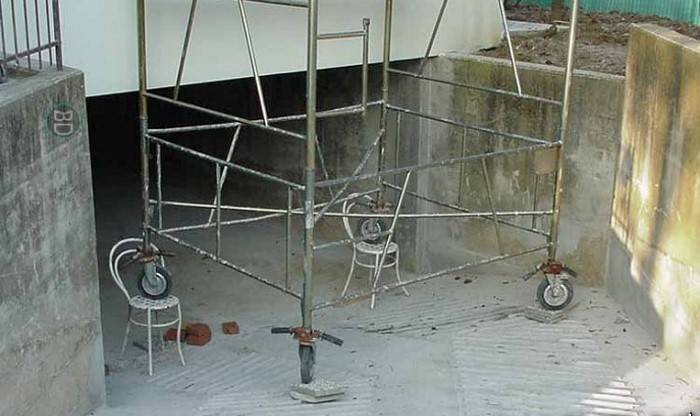Too often I've seen or (regretfully) been part of productions in which a grand vision --whether it be the director's or the set designer's-- fails to take into consideration the practical aspect of creating and building a set. For example, I've seen plays where half of the support struts don't touch the ground, where the dimensions of simple things like stairs or walls are ludicrously out of whack, and where a slammed on-stage door sends the whole set rocking. Each instance has, at times, completely overshadowed the play itself. And all of them could have been avoided if the right people had been involved early on in the creative process.
Don't get the wrong idea --I have never been a practical, experienced, and ingenuitive set constructor. I'm the one who comes up with the vague ideas that I can only really explain with hand gestures, finger pointing, and poorly simulated sound effects. But I know when I'm out of my element, and I'm not afraid to ask for help. Of course, asking for help is easier when one's boyfriend is a great set advisor/constructor (I can totally hook you up if you want, imaginary reader).
Case in point:
My current project is a proposal to stage M. Butterfly (and it's really starting to come together). My co-director (also one of my nearest and dearest friends) and I latched on to the idea of using scaffolding along all three walls of the stage to create levels and build on the overall aesthetic. For privacy/artistic license's sake I won't say more than that, but that's beside the point anyway.
The point is, I brought up the scaffolding idea with beloved boyfriend, and he jumped in right away to fill in the gaps in my practical knowledge. For instance, he pointed out that the upstage scaffolding can't just be erected straight across the wall, or else it will make everything else feel flat (which is, as you may know, the death knell for any theatre production). It has to have at least some depth to make it a little more appealing to the eye. And you know what? I never would have thought of that until the damn thing had been built, and then think of how much time and effort would have been wasted with still more needed to fix the problem. I would have spent lots of time ensuring that the blocking and set had depth and dynamism, but I would just have assumed that my original flat scaffolding idea was fine and then hoped that my set advisor/constructor would catch any potential issues.
And therein lies the problem! If my set advisor also lacked expertise, (s)he might not have thought about effective scaffolding techniques. Then, when the flawed idea made it down to the set constructor, (s)he --having so far been left out of the creative process-- might just build the set to those flawed specifications without voicing any artistic concern (I say "artistic" because "flat" scaffolding does not pose a safety threat). And then you end up with a noticeably flawed set. I've seen it happen! And I'm very glad that I have talent readily available to help make sure that it doesn't happen to my production.
Moral of the story: creative people, don't assume that you know what you're talking about when it comes to correctly balancing function with aesthetic, unless you have lots of experience building sets (especially if those sets are for impractical creative people). Collaborate with people who do! If they're any good and you treat them well, they'll make your set even better. Or, at least, they'll make sure that this doesn't happen:

No comments:
Post a Comment